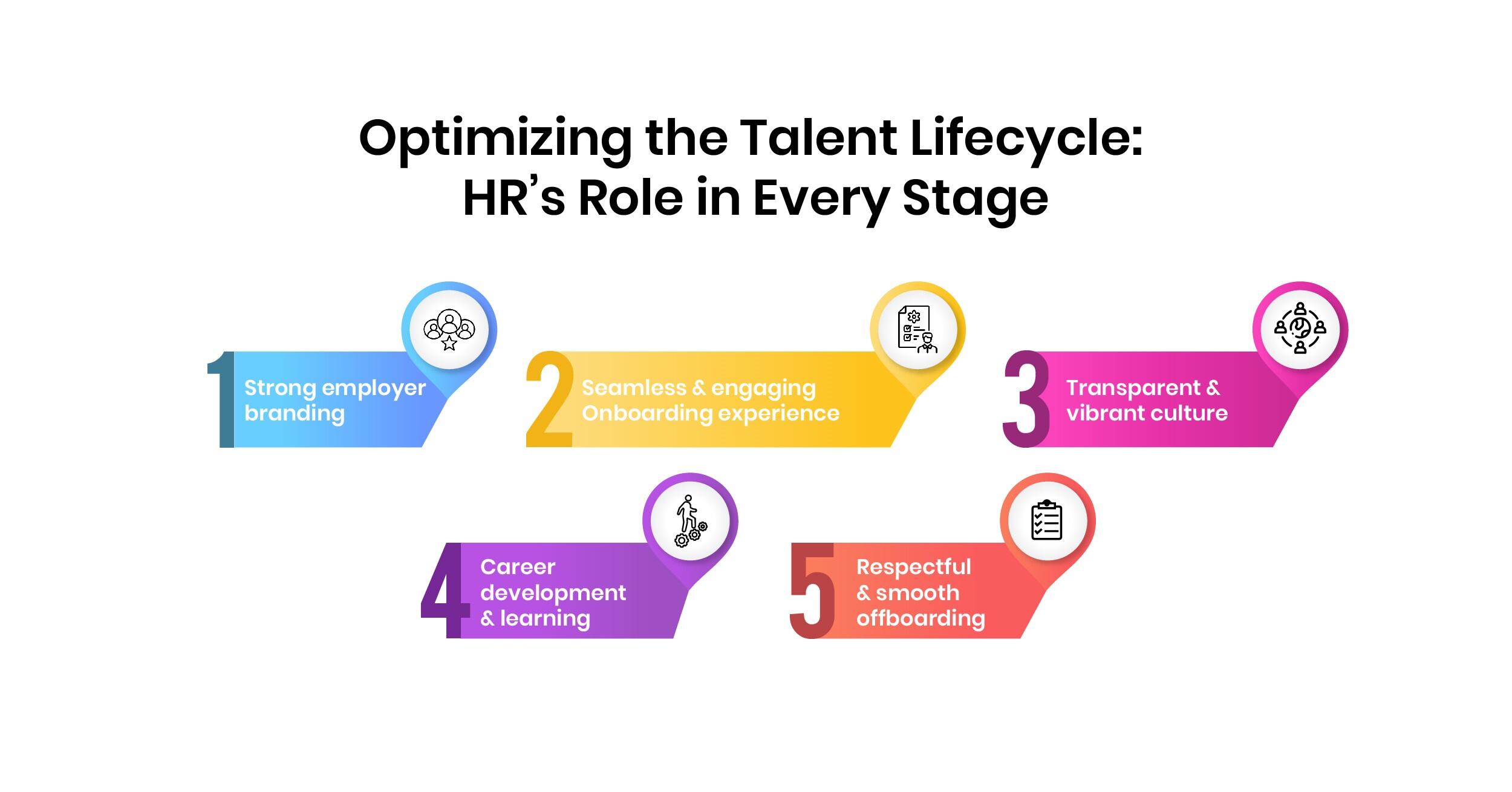The concept of a talent lifecycle refers to the different stages an employee goes through during their tenure at a company. Understanding and optimizing this lifecycle is key for organizations looking to attract, develop and retain top talent.
In this comprehensive guide, we will break down the five main phases of the talent lifecycle. We will also explore best practices for leveraging the talent management lifecycle to build a skilled, engaged workforce that drives business success.
The talent lifecycle represents the different stages an employee experiences throughout their time with a company. It covers the entire journey, from hiring to departure. Effectively managing this process is crucial for organizations aiming to enhance productivity, drive innovation, and support business growth.
Now let’s explore the 5 phases of the employee lifecycle in detail:

The recruitment phase involves everything from identifying open positions to attracting suitable candidates and finally securing the best hire. Essentially, it sets the foundation for acquiring prime talent that will propel business performance.
To excel at this stage, organizations need to:
Getting recruitment right is key. After all, bad hires that don’t fit the company culture or match job specifications tend to leave pretty quickly.
Onboarding refers to the process of welcoming and integrating new employees into the organizational culture. The goal is to make them feel comfortable, excited, and prepared to start contributing from day one.
Effective onboarding techniques involve:
When new hires have positive onboarding experiences, they become productive faster and are more likely to stick around long-term.
The engagement phase focuses on motivating talent, promoting collaboration, and nurturing happiness in the workplace. The aim is to help employees feel invested in company success through an engaging culture.
Tactics to boost engagement include:
Higher engagement leads to better performance, creativity, and loyalty. So, putting employee experience first pays off tremendously.
The learning and development stage concentrates on upskilling talent so they can take on more challenging assignments. It also prepares high-potential employees to take on leadership roles in the future.
Key components of learning initiatives include:
When people feel invested in, they become more motivated to excel in their current role while expanding skills. This leads to a robust leadership pipeline as well as higher retention.
The offboarding stage deals with employee exits, regardless of the reason. People may leave due to natural attrition, performance issues, retirement, family reasons, or better opportunities elsewhere.
Smooth offboarding processes entail:
Handling exits gracefully leaves a good impression and boosts employer brand in the long run. Plus, positive offboarding experiences mean there's a higher chance of rehiring former employees as boomerangs later on.
To drive business success, HR strategy needs to map closely to the talent lifecycle framework. Efforts should revolve around: 
To attract top talent, HR needs to focus on building an attractive employer brand that showcases the organization's values, culture, and employee experience. This involves developing compelling EVPs (employee value propositions) that speak to what makes the company stand out.
Specific steps HR can take include:
The end goal is conveying an authentic view of the employee experience to attract qualified, cultural-fit candidates to apply.
With the competition for talent intensifying, focus on onboarding is crucial for engagement and retention. HR needs to design onboarding as a strategic process that makes new hires excited for their roles.
Key steps in this include:
The outcome of robust onboarding is more empowered, productive employees who become long-term assets.
HR plays a pivotal role in cultivating a transparent, equitable work culture centered on trust and openness.
Key focus areas involve:
The goal is giving every employee a voice and agency. This boosts morale, connectivity and overall workplace culture.
Enabling continuous learning is pivotal to engaging and retaining top talent long-term. HR needs to take the lead in providing formal development pathways.
Tactics include:
The focus should be on empowering employee-driven development keyed to personal growth and organizational needs.
To preserve employer brand and relationships, HR needs to make the exit process smooth for leaving employees while capturing critical insights.
This hinges on:
The goal of dignified, human-centered offboarding is maintaining positivity and a door open for potential boomerangs.
When HR priorities align with the needs of talent at each step, it becomes easier to both attract and retain top performers. This leads to reduced hiring and training costs alongside higher productivity.
The talent lifecycle offers a blueprint for organizations looking to enhance recruitment, retention, and leadership development. By optimizing processes across the 5 talent lifecycle stages, HR teams can nurture a high-performance workforce driving organizational success.
The focus should be on attraction and acquisition of prime talent, smooth onboarding and integration, fostering employee engagement, promoting development and upskilling, and respectful offboarding.
When HR strategy aligns with the talent lifecycle model, it results in superior hiring quality, higher productivity, and lower turnover costs. This ultimately catalyzes innovation, profitability, and sustainable competitive advantage for the business.
This website uses cookies to enhance website functionalities and improve your online experience. By browsing this website, you agree to the use of cookies as outlined in our privacy policy .